Monolithic Power Systems Bundle
What's the Story Behind Monolithic Power Systems' Success?
Monolithic Power Systems (MPS) has quietly revolutionized how we manage power in our electronics. Founded in 1997, this Monolithic Power Systems SWOT Analysis offers a glimpse into its strategic moves. From its humble beginnings in San Jose, California, MPS has become a global force.
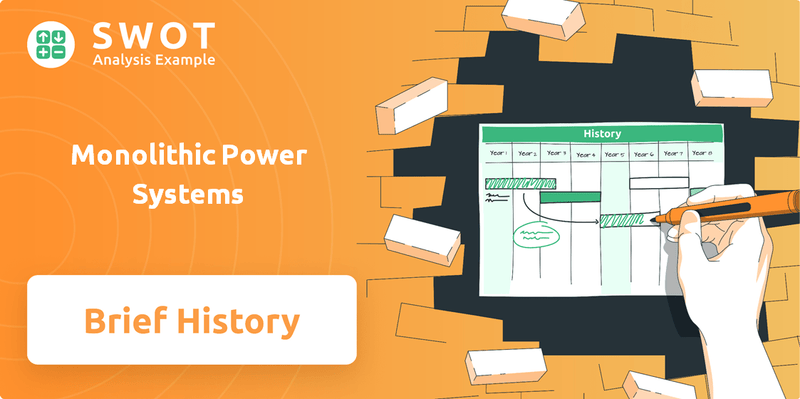
The MPS history is a testament to innovation and adaptability within the semiconductor industry. MPS's focus on designing efficient power management solutions, including DC-DC converters, has propelled its growth across multiple sectors. Understanding the MPS company timeline reveals a strategic journey marked by technological advancements and a keen awareness of market needs, solidifying its position as a leader.
What is the Monolithic Power Systems Founding Story?
The founding of Monolithic Power Systems (MPS) in 1997 marked the beginning of a significant player in the semiconductor industry. The company's inception was driven by a clear vision to revolutionize power management solutions. This vision aimed to address the inefficiencies and complexities prevalent in existing electronic systems.
Michael Hsing, the founder, brought extensive experience in the semiconductor field. He recognized the need for more integrated and efficient power management circuits. His goal was to create single-chip solutions that would improve efficiency, reduce component count, and lower costs.
The initial focus of the company was on designing and marketing advanced power management ICs to original equipment manufacturers (OEMs). MPS's early products were designed to tackle power conversion challenges in applications like computing and consumer electronics. The company's early days were characterized by intensive research and development. This was to perfect their proprietary BCD (Bipolar-CMOS-DMOS) process technology, which was essential for integrating different circuit types onto a single silicon die.
The initial business model of Monolithic Power Systems revolved around designing and marketing advanced power management ICs to OEMs. The company focused on addressing specific power conversion challenges in computing and consumer electronics.
- The company was initially bootstrapped, relying on Hsing's expertise.
- A lean operational model was used to develop foundational technologies.
- Intense R&D efforts were made to perfect the BCD process technology.
- The name 'Monolithic Power Systems' reflected the integrated, single-chip power solutions approach.
The early strategy of MPS was centered on innovation in power management. The company aimed to differentiate itself through its proprietary BCD process technology. This technology allowed for the integration of multiple power management functions onto a single chip. This approach was a departure from the more discrete component-based approaches common at the time. The company's focus on integrated circuits was a key factor in its early success. The company's early focus on power management solutions was a direct response to the growing need for more efficient and compact electronic devices. The company's early products were designed to meet the needs of computing and consumer electronics markets.
MPS's early success can be attributed to its innovative approach to power management. The company's focus on integrated circuits and efficient power solutions positioned it well in a rapidly evolving market. MPS's early products were designed to meet the needs of computing and consumer electronics markets. The company's early focus on power management solutions was a direct response to the growing need for more efficient and compact electronic devices.
The company's initial focus on specific market segments allowed it to gain a foothold. MPS was able to establish itself as a key player in the power management market. The company's early financial performance was marked by steady growth. MPS's early success was a result of its innovative products and strategic market focus. For more details on the company's strategic approach, you can read about the Target Market of Monolithic Power Systems.
Monolithic Power Systems SWOT Analysis
- Complete SWOT Breakdown
- Fully Customizable
- Editable in Excel & Word
- Professional Formatting
- Investor-Ready Format
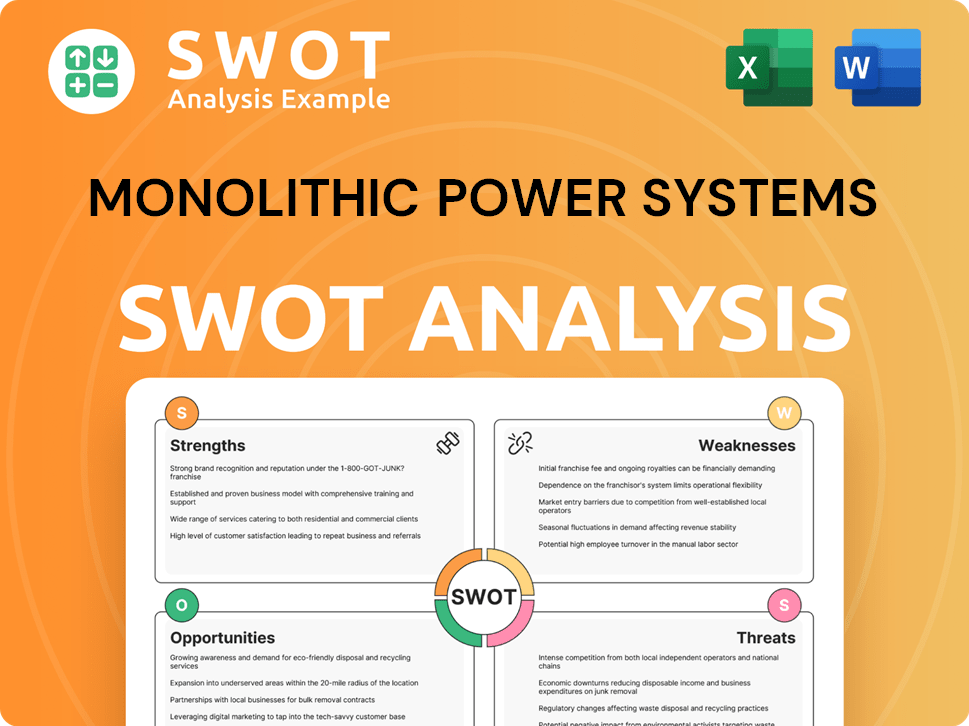
What Drove the Early Growth of Monolithic Power Systems?
The early growth of Monolithic Power Systems (MPS) was marked by a strong focus on its core expertise: highly integrated power management solutions. Founded in 1997, the MPS company quickly gained traction with its innovative integrated circuit (IC) designs. Early product launches, such as DC-DC converters, targeted the computing sector, offering better efficiency and smaller sizes than existing solutions. These early successes led to acquiring initial major clients, mainly in the PC and server markets.
As demand for more efficient power solutions increased, MPS expanded its product portfolio. The Semiconductor company began to penetrate new market segments, including industrial and automotive electronics. This expansion was supported by initial team growth and the establishment of design centers beyond its San Jose headquarters. The company's strategic decision to focus on high-performance, application-specific solutions helped it carve out a niche in a competitive landscape.
By the early 2000s, MPS started to expand its global footprint, recognizing the international nature of the electronics manufacturing industry. Key to this growth was the continuous refinement of its proprietary BCD process technology, which allowed for the development of increasingly complex and efficient power management ICs. Initial capital raises fueled research and development and expanded manufacturing capabilities, solidifying MPS's position for sustained growth. Further details can be found in this article about Owners & Shareholders of Monolithic Power Systems.
Monolithic Power Systems PESTLE Analysis
- Covers All 6 PESTLE Categories
- No Research Needed – Save Hours of Work
- Built by Experts, Trusted by Consultants
- Instant Download, Ready to Use
- 100% Editable, Fully Customizable
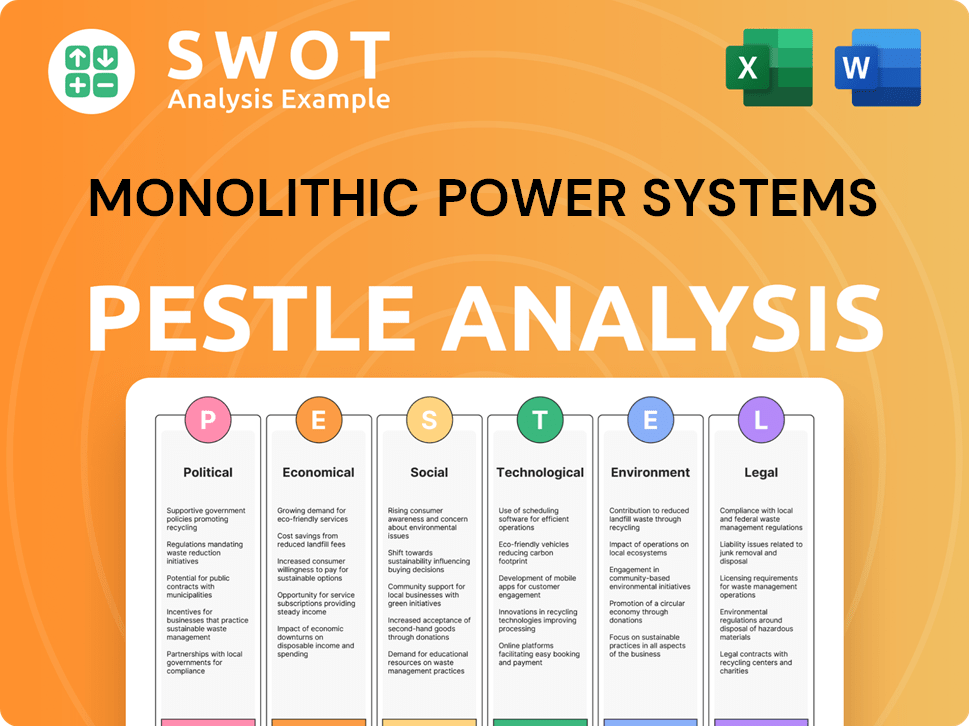
What are the key Milestones in Monolithic Power Systems history?
The journey of Monolithic Power Systems (MPS) has been marked by significant achievements and strategic pivots. From its inception, the MPS company has consistently pushed the boundaries of power management technology, establishing itself as a key player in the semiconductor industry. The MPS history is a testament to its adaptability and commitment to innovation, driving its evolution in a competitive market.
| Year | Milestone |
|---|---|
| 1997 | Monolithic Power Systems was founded, marking the beginning of its journey in power management solutions. |
| 2004 | MPS completed its initial public offering (IPO), a significant step in its growth and expansion. |
| 2010s | The company expanded its product portfolio and market reach, focusing on diverse applications and industries. |
| 2020 | MPS continued to innovate and expand, adapting to the evolving needs of the electronics market. |
Monolithic Power Systems has consistently focused on innovation, particularly in power management solutions. The company's advancements in BCD process technology have been crucial, enabling the creation of highly integrated and efficient power management ICs. These innovations have led to groundbreaking product launches across core markets, solidifying its technological leadership.
MPS's proprietary BCD process technology enables the integration of various functions on a single chip, leading to more efficient and compact power management solutions. This technology is a cornerstone of their product development, allowing for continuous improvements in performance and efficiency.
MPS has been at the forefront of developing high-frequency DC/DC converters, which are crucial for modern electronic devices. These converters offer improved efficiency and smaller form factors, meeting the demands of various applications.
MPS has developed advanced motor driver solutions for various applications, including automotive and industrial markets. These drivers enhance the performance and efficiency of motor-driven systems.
MPS has expanded its focus on the automotive sector, providing power management ICs for electric vehicles (EVs), advanced driver-assistance systems (ADAS), and in-vehicle infotainment. This expansion reflects the growing demand for efficient power solutions in the automotive industry.
MPS has also targeted the data center market, where energy efficiency is critical. They offer power management solutions that help reduce energy consumption and improve the performance of data center equipment.
MPS holds a substantial portfolio of patents, demonstrating its commitment to innovation. This intellectual property protects its technological advancements and provides a competitive advantage in the market.
Despite its successes, MPS has faced challenges inherent in the semiconductor industry. Intense competition and market fluctuations have required strategic adjustments, including a strong focus on research and development. For further insights into their strategic approach, consider reading about the Growth Strategy of Monolithic Power Systems.
The semiconductor industry is highly competitive, with numerous companies vying for market share. MPS faces pressure from both established players and emerging companies, requiring continuous innovation and differentiation.
Economic downturns can impact demand for electronic devices, affecting MPS's sales and financial performance. The company must navigate these periods by adjusting production levels and managing costs effectively.
Supply chain disruptions, such as those experienced during the COVID-19 pandemic, can create challenges in sourcing components and meeting customer demand. MPS must maintain a resilient supply chain to mitigate these risks.
The rapid pace of technological change requires MPS to continuously invest in research and development. Adapting to new technologies and market trends is essential for maintaining a competitive edge.
Geopolitical factors, such as trade tensions and tariffs, can affect the semiconductor industry. MPS must monitor these factors and adjust its strategies to minimize potential impacts.
Maintaining profitability in a competitive market requires efficient operations, cost management, and a focus on high-margin products. MPS must continually optimize its business model to ensure financial success.
Monolithic Power Systems Business Model Canvas
- Complete 9-Block Business Model Canvas
- Effortlessly Communicate Your Business Strategy
- Investor-Ready BMC Format
- 100% Editable and Customizable
- Clear and Structured Layout
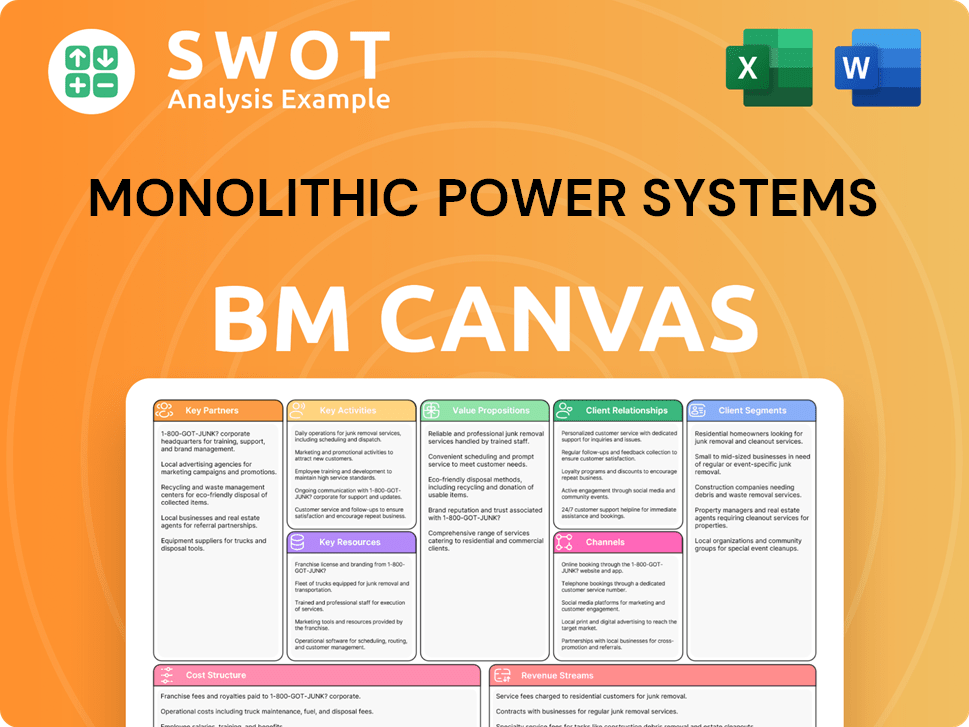
What is the Timeline of Key Events for Monolithic Power Systems?
The MPS history is marked by significant milestones, from its inception to its current position as a leading semiconductor company. Founded in 1997 in San Jose, California, Monolithic Power Systems (MPS) has consistently innovated, expanding its product offerings and market reach. Key developments include the launch of its initial DC-DC converter products, its public listing on the NASDAQ in 2004, and advancements in BCD process technology. MPS has strategically moved into new markets like consumer electronics and industrial applications, while also growing its presence in the automotive sector. The company has demonstrated strong financial performance, surpassing $250 million in annual revenue by 2015 and exceeding $1 billion by 2020.
| Year | Key Event |
|---|---|
| 1997 | Monolithic Power Systems (MPS) was founded in San Jose, California. |
| Early 2000s | MPS introduced its initial highly integrated DC-DC converter products, enhancing power management solutions. |
| 2004 | MPS went public and was listed on the NASDAQ stock exchange. |
| Mid-2000s | MPS expanded into new markets, including consumer electronics and industrial applications. |
| Late 2000s | MPS made significant advancements in its proprietary BCD process technology. |
| 2010s | MPS increased its focus and growth in the automotive sector with AEC-Q100 qualified products. |
| 2015 | MPS surpassed $250 million in annual revenue. |
| 2020 | MPS achieved over $1 billion in annual revenue, showcasing rapid growth. |
| 2021-2023 | MPS continued strong revenue growth, with 2023 revenue reaching approximately $1.82 billion. |
| 2024 | MPS focuses on AI data center power solutions and continued expansion in EVs and industrial applications. |
| 2025 | MPS is expected to continue strong growth driven by demand in high-performance computing and automotive electrification. |
MPS is strategically investing in solutions for AI data centers. This market is rapidly expanding, and requires highly efficient power management. MPS's advanced power solutions are crucial for the high-power demands of AI servers and GPUs. This focus is expected to drive significant revenue growth.
The accelerating shift towards EVs and advanced driver-assistance systems (ADAS) provides a significant growth avenue for MPS. Given its strong presence and expertise in automotive-grade power solutions, MPS is well-positioned to capitalize on this trend. This sector is a key area of expansion.
The industrial sector remains a core focus for MPS, with increasing demand for intelligent and efficient power systems. MPS continues to innovate and provide solutions that meet the specific needs of this market. This sector is expected to contribute to the company's sustained growth.
Analysts predict continued strong financial performance for MPS, with revenue expected to grow in 2024 and beyond. This growth will be driven by the company’s strategic focus on high-growth markets. Leadership emphasizes innovation and global market share expansion.
Monolithic Power Systems Porter's Five Forces Analysis
- Covers All 5 Competitive Forces in Detail
- Structured for Consultants, Students, and Founders
- 100% Editable in Microsoft Word & Excel
- Instant Digital Download – Use Immediately
- Compatible with Mac & PC – Fully Unlocked
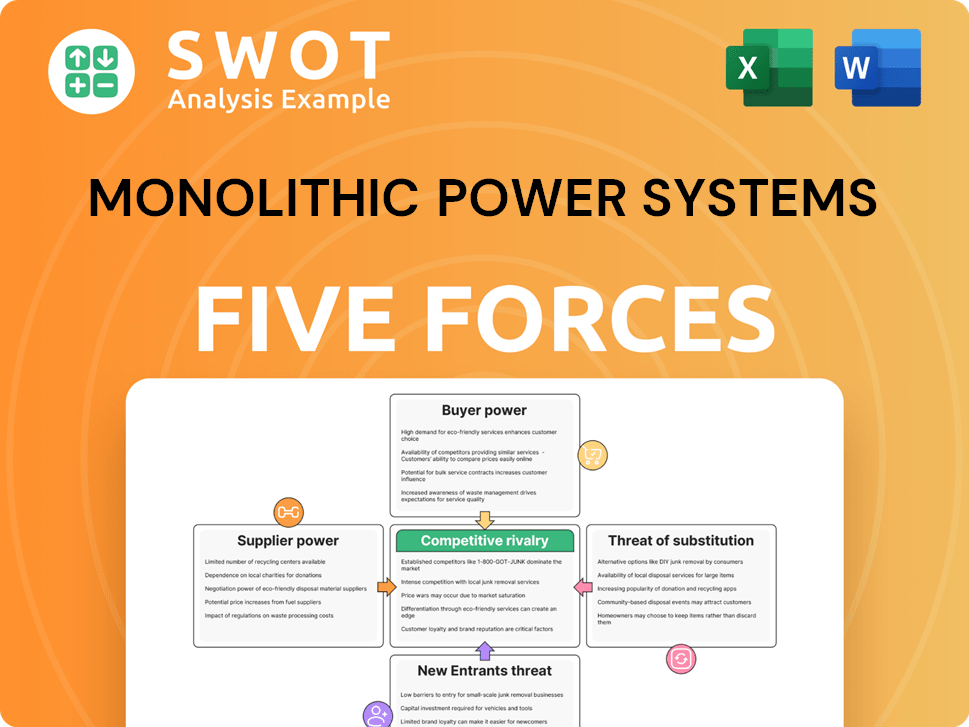
Related Blogs
- What is Competitive Landscape of Monolithic Power Systems Company?
- What is Growth Strategy and Future Prospects of Monolithic Power Systems Company?
- How Does Monolithic Power Systems Company Work?
- What is Sales and Marketing Strategy of Monolithic Power Systems Company?
- What is Brief History of Monolithic Power Systems Company?
- Who Owns Monolithic Power Systems Company?
- What is Customer Demographics and Target Market of Monolithic Power Systems Company?
Disclaimer
All information, articles, and product details provided on this website are for general informational and educational purposes only. We do not claim any ownership over, nor do we intend to infringe upon, any trademarks, copyrights, logos, brand names, or other intellectual property mentioned or depicted on this site. Such intellectual property remains the property of its respective owners, and any references here are made solely for identification or informational purposes, without implying any affiliation, endorsement, or partnership.
We make no representations or warranties, express or implied, regarding the accuracy, completeness, or suitability of any content or products presented. Nothing on this website should be construed as legal, tax, investment, financial, medical, or other professional advice. In addition, no part of this site—including articles or product references—constitutes a solicitation, recommendation, endorsement, advertisement, or offer to buy or sell any securities, franchises, or other financial instruments, particularly in jurisdictions where such activity would be unlawful.
All content is of a general nature and may not address the specific circumstances of any individual or entity. It is not a substitute for professional advice or services. Any actions you take based on the information provided here are strictly at your own risk. You accept full responsibility for any decisions or outcomes arising from your use of this website and agree to release us from any liability in connection with your use of, or reliance upon, the content or products found herein.